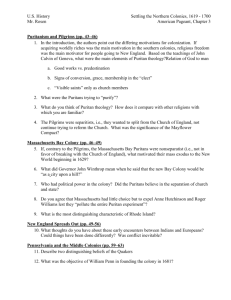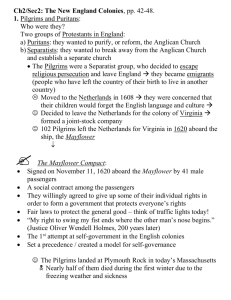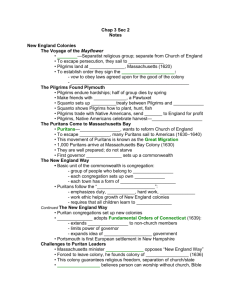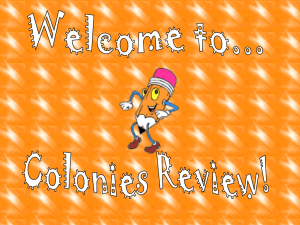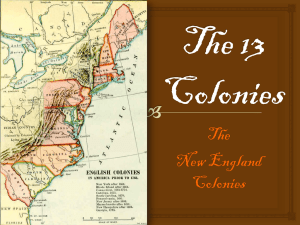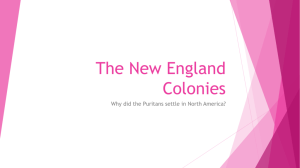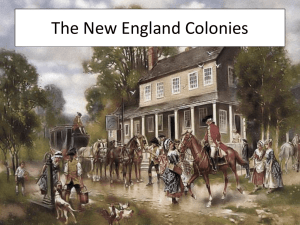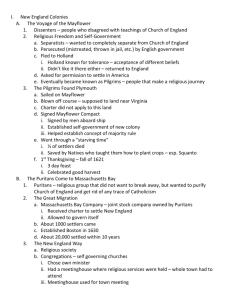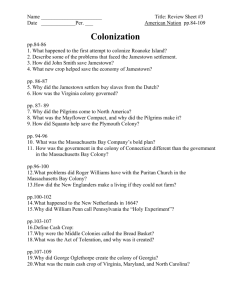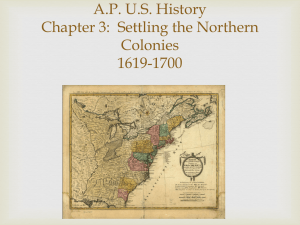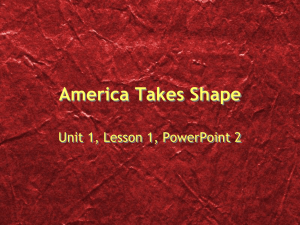Chapter 3.2 – The New England Colonies, pp. 78-84 Pre
advertisement
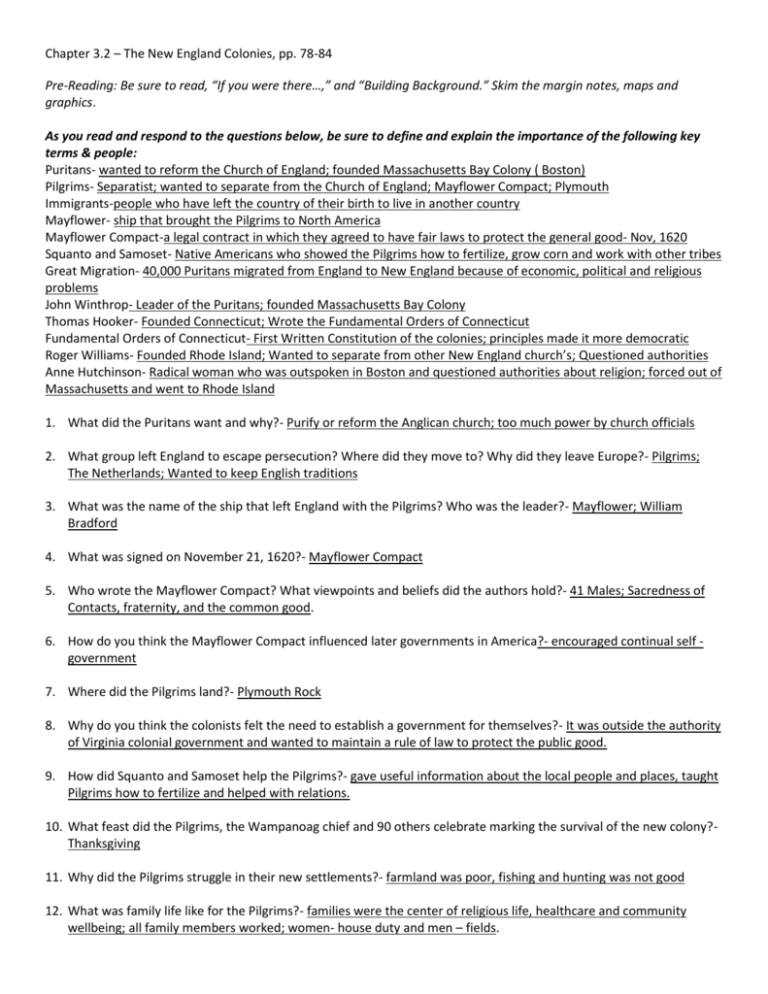
Chapter 3.2 – The New England Colonies, pp. 78-84 Pre-Reading: Be sure to read, “If you were there…,” and “Building Background.” Skim the margin notes, maps and graphics. As you read and respond to the questions below, be sure to define and explain the importance of the following key terms & people: Puritans- wanted to reform the Church of England; founded Massachusetts Bay Colony ( Boston) Pilgrims- Separatist; wanted to separate from the Church of England; Mayflower Compact; Plymouth Immigrants-people who have left the country of their birth to live in another country Mayflower- ship that brought the Pilgrims to North America Mayflower Compact-a legal contract in which they agreed to have fair laws to protect the general good- Nov, 1620 Squanto and Samoset- Native Americans who showed the Pilgrims how to fertilize, grow corn and work with other tribes Great Migration- 40,000 Puritans migrated from England to New England because of economic, political and religious problems John Winthrop- Leader of the Puritans; founded Massachusetts Bay Colony Thomas Hooker- Founded Connecticut; Wrote the Fundamental Orders of Connecticut Fundamental Orders of Connecticut- First Written Constitution of the colonies; principles made it more democratic Roger Williams- Founded Rhode Island; Wanted to separate from other New England church’s; Questioned authorities Anne Hutchinson- Radical woman who was outspoken in Boston and questioned authorities about religion; forced out of Massachusetts and went to Rhode Island 1. What did the Puritans want and why?- Purify or reform the Anglican church; too much power by church officials 2. What group left England to escape persecution? Where did they move to? Why did they leave Europe?- Pilgrims; The Netherlands; Wanted to keep English traditions 3. What was the name of the ship that left England with the Pilgrims? Who was the leader?- Mayflower; William Bradford 4. What was signed on November 21, 1620?- Mayflower Compact 5. Who wrote the Mayflower Compact? What viewpoints and beliefs did the authors hold?- 41 Males; Sacredness of Contacts, fraternity, and the common good. 6. How do you think the Mayflower Compact influenced later governments in America?- encouraged continual self government 7. Where did the Pilgrims land?- Plymouth Rock 8. Why do you think the colonists felt the need to establish a government for themselves?- It was outside the authority of Virginia colonial government and wanted to maintain a rule of law to protect the public good. 9. How did Squanto and Samoset help the Pilgrims?- gave useful information about the local people and places, taught Pilgrims how to fertilize and helped with relations. 10. What feast did the Pilgrims, the Wampanoag chief and 90 others celebrate marking the survival of the new colony?Thanksgiving 11. Why did the Pilgrims struggle in their new settlements?- farmland was poor, fishing and hunting was not good 12. What was family life like for the Pilgrims?- families were the center of religious life, healthcare and community wellbeing; all family members worked; women- house duty and men – fields. 13. How did the Pilgrims view women and children?- They were valued; they traveled together to North AmericaChildren were educated; women had more rights than in England. 14. What factors led to the Great Migration, and why was is it significant?- Economic hardships, political crisis and religious persecution of the Puritans in England- led the founding of the New England colonies. 15. In what year did the Puritans land in Massachusetts? What was the name of their Company? Who was the leader?1630; Massachusetts Bay; John Winthrop 16. What role did religion play in the establishment of the Massachusetts Bay Colony?- Religious persecution contributed to the Great Migration; Puritans believed they had a covenant with God establish an ideal Christian Community 17. What was the function of the General Court in Massachusetts Bay Colony?- Each town in the colony sent delegates to the Court, which served as the governing body. 18. How was religion connected to government in the New England colonies?- Government leaders had to be church members, ministers often had a great deal of power and only male church members could vote. 19. Who left Massachusetts and founded Connecticut?- Thomas Hooker 20. How was Connecticut’s government distinctive?- Connecticut had the Fundamental Orders of Connecticut which allowed men who were not church members to vote- made government more democratic; set up a guideline on how the colony was going to be governed. 21. What did Roger Williams and Anne Hutchinson have in common?- Both were forced to leave Massachusetts because of religious views; formed settlements in Rhode Island 22. What led to 19 people being put to death because of witchcraft?- Salem Witch Trials 23. What led to religious disagreements among the Puritans and what was the result?- Different views on religion, on mixing government and religion, and on relations with Native Americans; forced to leave- dissenters established new settlements in New England. 24. What class of people gained power and wealth from trade in the New England colonies?- merchants 25. How did the climate and terrain of New England make slavery unpopular in this area?- little demand for labor because of the few New England farms, grew cash crops. 26. What was the first college in New England, and why was it founded?- Harvard College; to ensure educated ministers for the future 27. Why was education important to the New England colonies?- Parents wanted their children to be able to read the Bible and to ensure that future generations had educated ministers. 28. How did education in the New England colonies differ from that in Virginia?- New England- many communities provided public schooling to ensure that children could read and write. Virginia- schools were not provided parents taught children or they had private tutors, fewer children could read or write.
